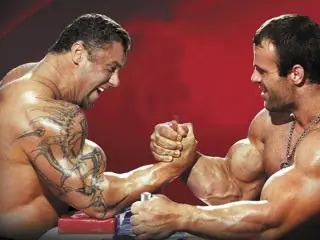In this article we will study such important anatomical concepts as supination and pronation. Do you recognize what these movements are? What muscles of our body are responsible for them? How to train these muscles? And in what sports are they mainly involved? So, we have outlined the agenda for the article, and we will immediately begin answering all the above questions...
From an anatomical point of view, pronation and supination are a set of rotational movements of our upper and lower extremities, controlled by special muscle groups: pronators and supinators. To make it more clear, let’s explain with a specific example: bend your lowered arm at the elbow and fix your hand so that your thumb points up and all other fingers point forward. Now rotate your hand so that your thumb moves inward and downward. In this case, your entire hand will smoothly move from a vertical position to a horizontal one, and your palm will look down - this rotational movement of the hand (and forearm, respectively) is called pronation.
Now from this position (palm down), rotate the hand in the opposite direction so that, ultimately, the palm turns upward - this movement of the hand and forearm is called supination. In this case, we looked at the rotational movements of the upper limbs; with our legs, everything is fundamentally the same: from a lying or sitting position, stretch your legs forward so that your toes point straight up. Try turning your foot (or both at once) towards the other foot - this is a pronation movement. Accordingly, rotation in the opposite direction will be supination.
As you can see, the principle of operation of the arms and legs is similar, with the only difference being that the amplitude of available movement of the lower extremities is significantly less than the amplitude of movement of the arms. All this is connected with evolutionary processes - just as our toes (and in particular the big toe) are poorly used by us compared to their counterparts on the hands, in the same way, the rotational movements of the legs are largely inferior to the similar movements of the arms of our body. It is for this reason that our entire further story will mainly concern the hands. And we told you about legs, so to speak, for reference, for general development...
- and torso muscles
- and deltoid group,
- and muscles of the thoracic region,
- and, of course, triceps...
The arm, abducted in a bent position, sharply straightens forward. At the same time, pay attention to the rotational movement of the fist itself - a clear example of pronation of the hand and forearm. As a similar example for the lower limb, we will give you a side kick - yokogeri, widely known in karate, kickboxing, taikwondo and other martial arts disciplines. Similar to the arm, the leg is thrown out to the side from the initial bent position, while the foot itself is turned to the side almost parallel to the ground - a classic element of pronation of the athlete’s foot.
As mentioned above, if you think about it, it becomes clear that these rotational elements are involved to some extent in almost every movement we make. Consequently, the muscles that carry them out also play an important role in our lives.
But for us bodybuilders, of course, the degree of importance of these muscle groups in the bodybuilding process is curious. So, how important are these muscles for a bodybuilder? In fact, pronators and supinators are small muscles in size and volume, so many athletes don’t even know their names. Have you heard of them before? - hardly! But biceps, triceps and quadriceps are known to everyone, almost from kindergarten age...
- Reverse dumbbell curl.
- Zotman curls.
- Work on the “Brush strengthener” simulator.
- All kinds of bending and rotation of the hand on an elbow expander.
All these points can significantly strengthen the rotatory muscles of your arms.
But those who are most interested in the serious development of supinators and pronators are modern armwrestlers. In arm wrestling, strong pronation and supination are the key to victory! Remember for yourself how this happens: athletes grab each other’s hands, and at the judge’s signal, they try to sharply twist the opponent’s palm first, and then put the pressure on him with their entire shoulder. It is for this reason that arm wrestlers must train pronation day and night - because this is the most key movement in their entire struggle, without sufficient preparation of which they will never achieve a serious victory. Here, again, the elbow expanders we discussed earlier and specialized spring simulators for developing explosive strength in this movement will help them.
That, probably, is all that we planned to tell you in this article. Stay tuned, there is still a lot of interesting things ahead!
Post Views: 1,170


